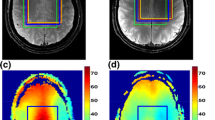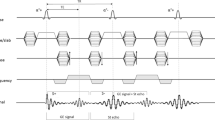Abstract
The objective was to demonstrate the feasibility and to evaluate the performance of high-resolution in vivo magnetic resonance (MR) imaging of the rat spinal cord in a 17.6-T vertical wide-bore magnet. A probehead consisting of a surface coil that offers enlarged sample volume suitable for rats up to a weight of 220 g was designed. ECG triggered and respiratory-gated gradient echo experiments were performed on a Bruker Avance 750 wide-bore spectrometer for high-resolution imaging. With T*2 values between 5 and 20 ms, good image contrast could be obtained using short echo times, which also minimizes motion artifacts. Anatomy of healthy spinal cords and pathomorphological changes in traumatically injured rat spinal cord in vivo could be visualized with microscopic detail. It was demonstrated that imaging of the rat spinal cord in vivo using a vertical wide-bore high-magnetic-field system is feasible. The potential to obtain high-resolution images in short scan times renders high-field imaging a powerful diagnostic tool.
Similar content being viewed by others
References
Meyerand ME, Cremillieux Y, Wadghiri YZ et al. (1998) In vivo gradient echo microimaging of rodent spinal cord at 7 T. Magn Reson Med 40:789–791
Fenyes DA, Narayana PA (1998) In vivo echo-planar imaging of rat spinal cord. Magn Reson Imaging 16:1249–1255
Narayana P, Fenyes D, Zacharopoulos N (1999) In vivo relaxation times of gray matter and white matter in spinal cord. Magn Reson Imaging 17:623–626
Franconi F, Lemaire L, Marescaux L et al. (2000) In vivo quantitative microimaging of rat spinal cord at 7 T. Magn Reson Med 44:893–898
Benveniste H, Qui H, Hedlund LW et al. (1998) Spinal cord neural anatomy in rats examined by in vivo magnetic resonance microscopy. Reg Anesth Pain Med 23:589–599
Fenyes DA, Narayana PA (1999) In vivo diffusion characteristics of rat spinal cord. Magn Reson Imaging 17:717–722
Fenyes DA, Narayana PA (1999) In vivo diffusion tensor imaging of rat spinal cord with echo planar imaging. Magn Reson Med 42:300–306
Elshafiey I, Bilgen M, He R, Narayana PA (2002) In vivo diffusion tensor imaging of rat spinal cord at 7 T. Magn Reson Imaging 20:243–247
Fraidakis M, Klason T, Cheng H et al. (1998) High-resolution MRI of intact and transected rat spinal cord. Exp Neurol 153:299–312
Benveniste H, Qui H, Hedlund LW et al. (1999) In vivo diffusion-weighted magnetic resonance microscopy of rat spinal cord: Effect of ischemia and intrathecal hyperbaric 5% lidocaine. Reg Anesth Pain Med 24:311–318
Bilgen M, Abbe R, Narayana PA (2001) Dynamic contrast-enhanced MRI of experimental spinal cord injury: In vivo serial studies. Magn Reson Med 45:614–622
Gareau PJ, Weaver LC, Dekaban GA (2001) In vivo magnetization transfer measurements of experimental spinal cord injury in the rat. Magn Reson Med 45:159–163
Bilgen M, Dogan B, Narayana PA (2002) In vivo assessment of blood-spinal cord barrier permeability: Serial dynamic contrast enhanced MRI of spinal cord injury.Magn Reson Imaging 20:337–341
Malisza KL, Stroman PW, Turner A et al. (2003) Functional MRI of the rat lumbar spinal cord involving painful stimulation and the effect of peripheral joint mobilization. J Magn Reson Imaging 18:152–159
Chen CN, Hoult DI (1989) Biomedical magnetic resonance technology. Adam Hilger, Bristol
Scheff SW, Rabchevsky AG, Fugaccia I et al. (2003) Experimental modeling of spinal cord injury: Characterization of a force-defined injury device. J Neurotrauma 20:179–193
Silver X, Ni WX, Mercer EV et al. (2001) In vivo 1H magnetic resonance imaging and spectroscopy of the rat spinal cord using an inductively-coupled chronically implanted RF coil. Magn Reson Med 46:1216–1222
Bilgen M, Elshafiey I, Narayana PA (2001) In vivo magnetic resonance microscopy of the rat spinal cord at 7 T using implantable RF coils. Magn Reson Med 46:1250–1253
Anderson SA, Shukaliak-Quandt J, Jordan EK et al. (2003) Cellular MR imaging of magnetically labeled encephalitogenic T-cells in the mouse spinal cord. Proc Int Soc Magn Reson Med 11:763
Bonny JM, Gaviria M, Donnat JP (2004) Nuclear magnetic resonance microimaging of mouse spinal cord in vivo. Neurobiol Dis 15:474–482
Gibbs RA, Weinstock GM, Metzker ML et al. (2004) Genome sequence of the Brown Norway rat yields insights into mammalian evolution. Nature 428:493–521
Hayes CE, Edelstein WA, Schenck JF et al. (1985) An efficient, highly homogeneous radiofrequency coil for whole-body NMR imaging at 1.5 T. J Magn Reson 63:622–628
Acknowledgments.
We would like to acknowledge Sebastian Aussenhofer for his expert technical assistance, Ines Wieland for help with building the resonator, and Vikas Gulani for comments on the manuscript. This work was funded by the “Deutsche Forschungsgemeinschaft (DFG)” under project number “HA 1232/13”.
Author information
Authors and Affiliations
Corresponding author
Additional information
Volker C. Behr and Thomas Weber contributed equally to this work.
Rights and permissions
About this article
Cite this article
Behr, V., Weber, T., Neuberger, T. et al. High-resolution MR imaging of the rat spinal cord in vivo in a wide-bore magnet at 17.6 Tesla. MAGMA 17, 353–358 (2004). https://doi.org/10.1007/s10334-004-0057-5
Received:
Revised:
Accepted:
Published:
Issue Date:
DOI: https://doi.org/10.1007/s10334-004-0057-5




